[continued from Working at Cross-Purposes (pt. 1)]
There must be something about autumn because, here I am, a year later, back on this project.
As mentioned in the first part of this rambling, incoherent stream of blasphemy, after finishing the crucifix project, I became more and more aware that I wasn’t done, yet, that the crucifix was just one small part of a larger piece.
How was I to know, that fateful day when I picked up the chunky, wooden crucifix with the corny, plastic corpus on it from the shelf at Goodwill, that it would lead to me building a devotional cabinet?
Well it did.
I suppose it is here that I should admit to being raised by a carpenter – a jack of all trades, really: electrical, drywall, refinishing, cabinet making, restoration, fabrication, engineering, mechanical: you name it, the man could do it all. I watched from the sidelines, feeling incapable, berated as the same … and yet, the influence was great enough that I frequently have carpentry related urges. Foolish urges helped along by the laughable illusion that, having been raised by a carpenter, I am genetically and, through exposure, imbued with all the knowledge and skill one needs to conceive and complete any project idea that wanders unsuspecting into the house of mirrors I like to think of as my brain.
And so I begin to think: could I create the arch-topped cabinet like the one I saw in my head. I look at a number of devotional cabinets online and the idea begins to take much more solid form.
Without a router, band, saber, or jig saw in my humble shop, I know I need to find source materials as close as possible to the basic shape I have in mind. Later that very day, I run across two panels of wood at Goodwill that are absolutely perfect for what I am thinking of: discarded spoon collection racks.
 Now I don’t know what it is that compels someone to collect spoons (wrote the man with 101 inexplicable collections) but it’s a widely enough practiced hobby that there are racks made to display them – racks made of wood with clunky arches and scrolling.
Now I don’t know what it is that compels someone to collect spoons (wrote the man with 101 inexplicable collections) but it’s a widely enough practiced hobby that there are racks made to display them – racks made of wood with clunky arches and scrolling.
It is as if a divine hand is coming down to provide me the materials required to help me lampoon the shape men have given it on earth.
Approximately 16” x 18” x 1″, I can already see how a few minor cuts will transform these ugly things into the back and doors of my proposed devotional cabinet. The wood is solid, heavy, the price right. $8 later they are on their way to my shop.
 The first thing I do is some measuring and – whack! – off come the spoon rack bars and bottoms of the remaining panels; and just like that I have the basic shape of my cabinet. I carefully bisect the slightly smaller panel and now I have my cabinet doors. Hotcha.
The first thing I do is some measuring and – whack! – off come the spoon rack bars and bottoms of the remaining panels; and just like that I have the basic shape of my cabinet. I carefully bisect the slightly smaller panel and now I have my cabinet doors. Hotcha.
Comparing the depth of my crucifix with some wood scraps, I come to the conclusion that my cabinet will achieve the appropriate depth with one-by-twos. I do some more measuring and sawing: voila – the makings of my cabinet are before me – but how to go about it?
In my mind, I see a worn, beaten, aged decoration. A devotional cabinet that’s been around a long, long while and seen better days. How will I achieve this look and, further, how dedicated to the illusion should I be?
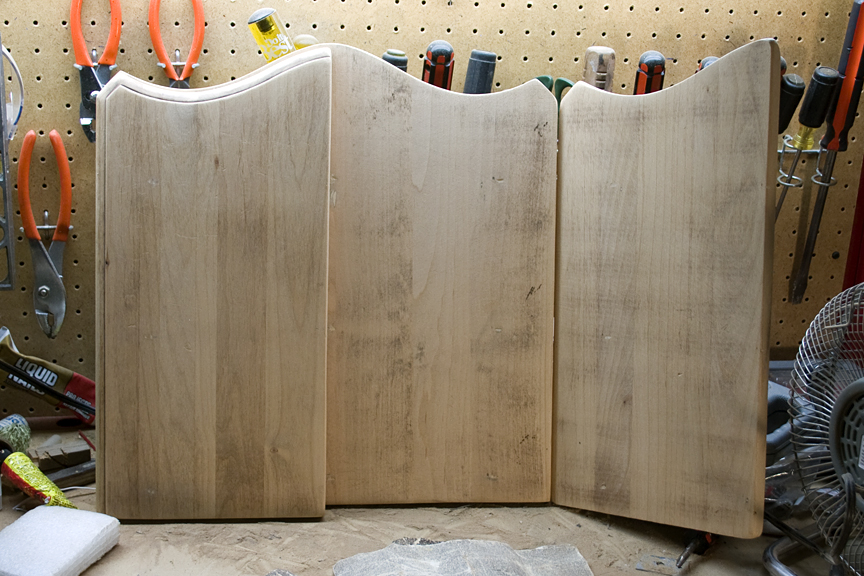 I sand the existing finish off the back and doors of the cabinet – by hand! ugh! – then re-stain it with a dark stain. The wood is rich and dark – lustrous. All wrong, in other words.
I sand the existing finish off the back and doors of the cabinet – by hand! ugh! – then re-stain it with a dark stain. The wood is rich and dark – lustrous. All wrong, in other words.
Of a sudden it comes to me to construct this cabinet using no metal. I will, instead, hammer it together with wooden pegs and glue. Oh, yeah: I like that! A length of ⅛” inch dowel waves at me from my scrap pile: “Hey, I can help … “
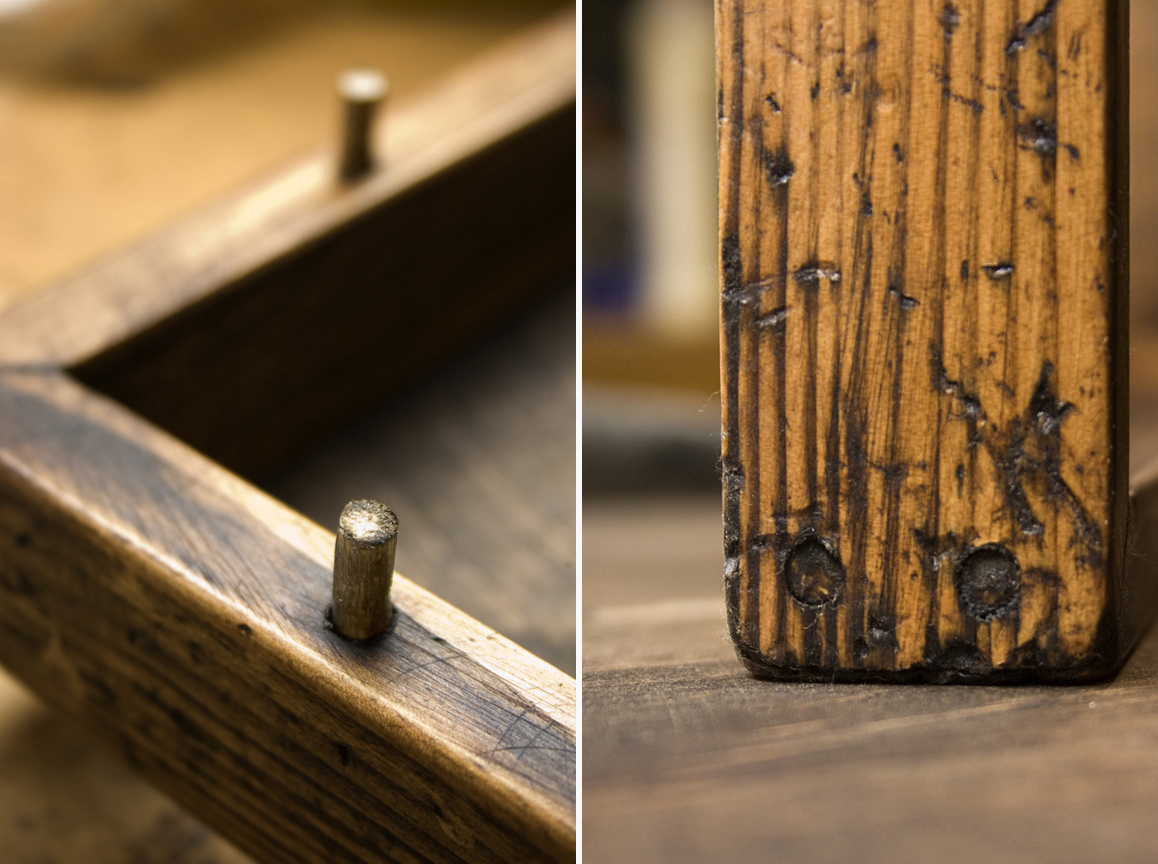 I play around with the box frame and soon have it drilled and pegged together and it looks great! I drill a few more holes and peg it to the backing board of the cabinet. I lay the doors atop this and, wow – I feel like I’m almost home!
I play around with the box frame and soon have it drilled and pegged together and it looks great! I drill a few more holes and peg it to the backing board of the cabinet. I lay the doors atop this and, wow – I feel like I’m almost home!
Next comes antiquing. I take the stained but unsealed box and separate doors outside and proceed to beat the snot out of them on the sharp gravel drive. My freshly glued and stained cabinet all but comes apart during the process and I am both invigorated and horrified – what if I accidentally go too far? The idea behind the violence is to create dents, splinterings, and scratches that have this darker stain worked into them. Finding an arbitrary stopping point, I then sand all but about 10% of the dark color back off and stain it again with a lighter tone.
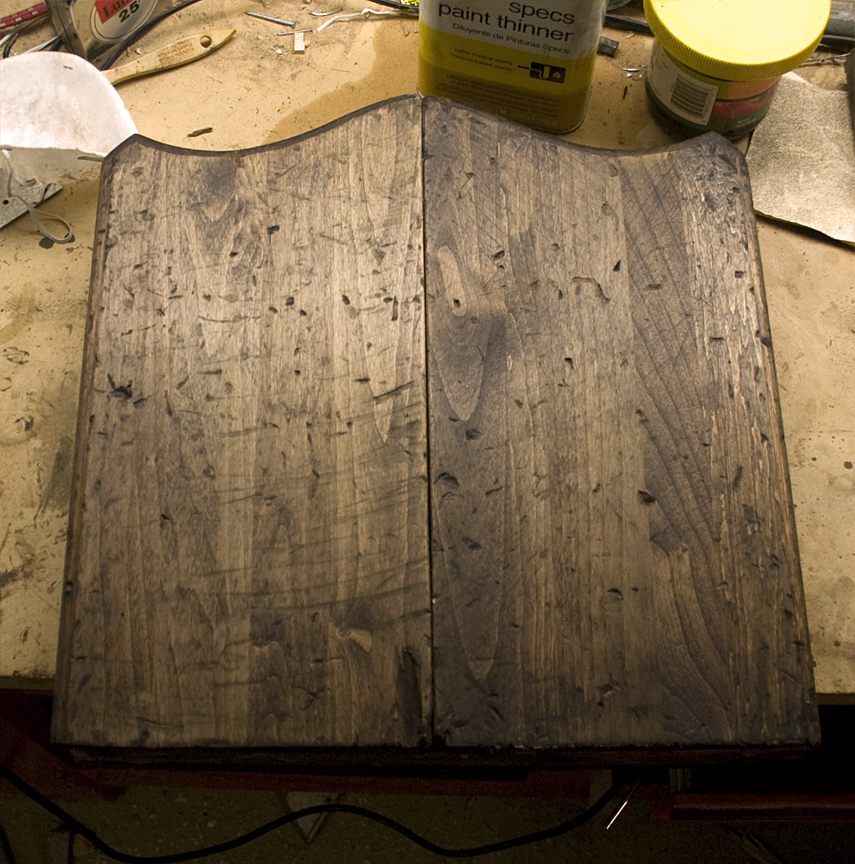 The effect achieved is fabulous to my eyes but the more I look at the rectangular frame of the box for my cabinet, the more disappointed I am. My inspiration has an arched top, My back board and doors arch at the top. My cabinet frame, on the other hand, is rectangular. The crucifix looks good in place but I know it could look better, much better.
The effect achieved is fabulous to my eyes but the more I look at the rectangular frame of the box for my cabinet, the more disappointed I am. My inspiration has an arched top, My back board and doors arch at the top. My cabinet frame, on the other hand, is rectangular. The crucifix looks good in place but I know it could look better, much better.
I decide to give sawing out my own, arched top a try. I have a couple of coping saws but we’re talking about creating a curving shape out of a chunk of 6” x 2” without a jig or a skilled hand.
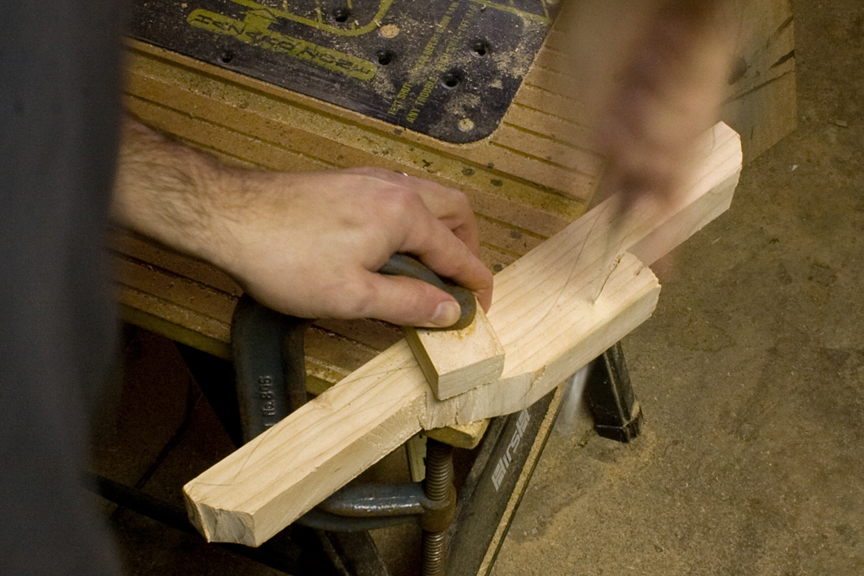 I think I attempted two and a half of them before I have to admit I am in over my head. I simply cannot keep the blade properly vertical. While my cut follows the line on the side I can see, it wanders back and forth like a maniac on the other side, no matter my speed or concentration. The end result is some ugly-ass kindling.
I think I attempted two and a half of them before I have to admit I am in over my head. I simply cannot keep the blade properly vertical. While my cut follows the line on the side I can see, it wanders back and forth like a maniac on the other side, no matter my speed or concentration. The end result is some ugly-ass kindling.
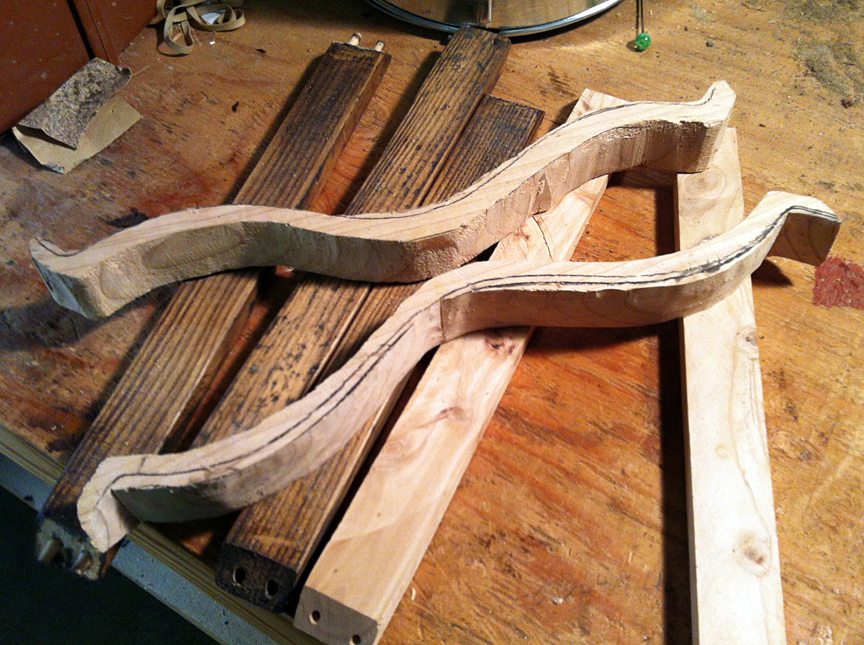 I moan about the situation to my wife and she suggests I ask our neighbor, a chainsaw artist, if he knows of anyone who has a band or scroll saw I can use. She also mentions the cabinet shop in town that would probably hew out the shape I need for a sawbuck (pun intended).
I moan about the situation to my wife and she suggests I ask our neighbor, a chainsaw artist, if he knows of anyone who has a band or scroll saw I can use. She also mentions the cabinet shop in town that would probably hew out the shape I need for a sawbuck (pun intended).
These options sound both reasonable and repellent to me. I want this project to be mine and feel dedicated to completing it with my own hands. I become convinced I can pull off the arch of the frame’s top if only I had a jig saw at my disposal.
In the meantime, another poser is gumming up the images in my head of the finished project: what of hinges? What do I use? Leather straps? Metal? If metal, what kind? What’s the history of hinges? Should I use a mix of hinging techniques to indicate replacement over the years?
I poke around on the internet for hinge types and information, trying to formulate in my mind what it is I want but it’s a surprisingly frustrating process. I even hit a place that advertises “4,000 different hinges in stock!” They do, indeed, have a ton of hinges to browse but not one that fits what I have in mind – probably because what I have in mind is nebulous.
In my searches, I run across the concept of making hinges out of wood and a light goes on in my head – of course! No metal *at all* in the piece! Yes! I’ll make the hinges, make the arch top, then I’ll … oh, yeah. I can’t make the arch top with the tools I have and now I expect myself to be able to whittle out something even finer like hinges?
It looks so danged *easy* though. One site has a pdf with a pattern and pictorial, step by step instructions and another directs me to some videos detailing a different approach to making a wooden hinge.
Feeling like an expert, I march right out to my shop and, in no time at all, have created a small pile of wood scraps. I lack not only the skill but, as I already knew, the tools as well. Nearly all the tools I have are second-hand or cheapish: bits and blades old, dull, worn, or of general grade and general purpose.
The roadblock is frustrating – I’m an impatient craftsman – and, for the first time in my life, I begin to really drool over tool catalogs. In discussing my progress on the project, I rattle off dream tools to my wife: it is early December and I am no fool.
Sure enough, come Christmas, my wife has gotten for me, among other things, an electric jig saw. I am dying to try it and, before my Christmas holiday is over, two further attempts at the arch are made – and fail for the same reason as before. Even though I am now able to maintain my cut with level and even strokes, the blade still wanders. I try different types of blades and speeds but to no avail: the board is apparently just too thick for the tool to bull through the curves with any accuracy.
In a phone call to my brother, who is much more of a carpenter, he suggests making cuts every few inches or so in at right angles to my proposed line, which should help minimize the wandering blade syndrome. I give this a half-assed shot, again to no avail.
At this point, I am gritting my teeth and feeling like an utter failure. Knowing that the intended piece is well beyond the cabinet portion I am presently stuck on, I wonder how on earth I’ll ever manage to pull any of it off.
It is early January 2013 – nearly ten months will pass before I touch the project again.

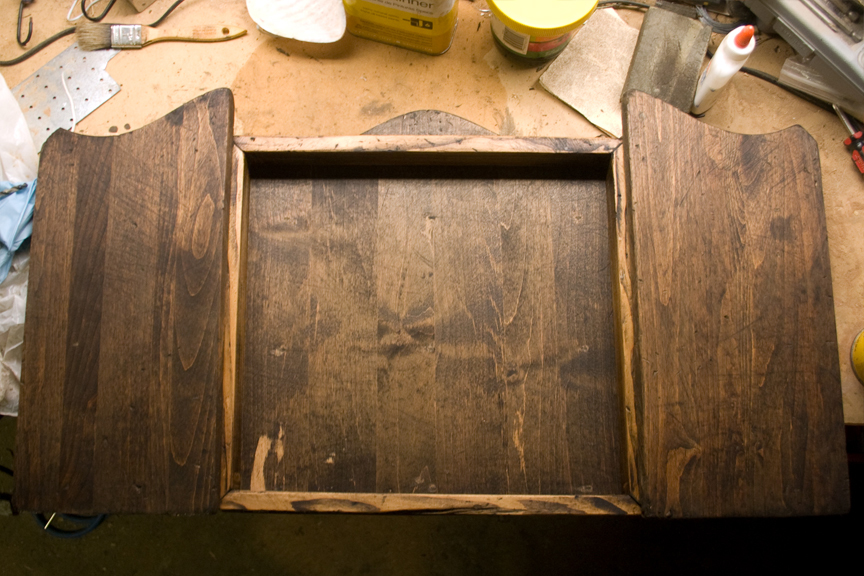

[…] Part 2 is here […]
[…] [continued from Working at Cross-Purposes (pt. 2)] […]